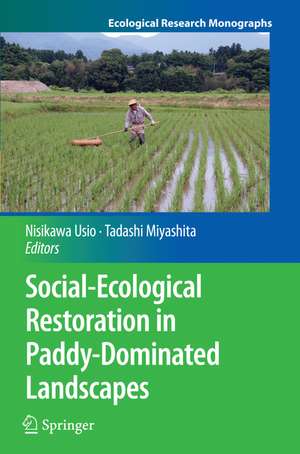Social-Ecological Restoration in Paddy-Dominated Landscapes: Ecological Research Monographs
Editat de Nisikawa Usio, Tadashi Miyashitaen Limba Engleză Paperback – 8 oct 2016
Din seria Ecological Research Monographs
- 18%
 Preț: 892.90 lei
Preț: 892.90 lei - 18%
 Preț: 947.50 lei
Preț: 947.50 lei - 15%
 Preț: 641.53 lei
Preț: 641.53 lei - 18%
 Preț: 1119.87 lei
Preț: 1119.87 lei - 18%
 Preț: 1235.08 lei
Preț: 1235.08 lei - 18%
 Preț: 1114.21 lei
Preț: 1114.21 lei - 18%
 Preț: 1123.35 lei
Preț: 1123.35 lei - 24%
 Preț: 772.24 lei
Preț: 772.24 lei - 24%
 Preț: 836.70 lei
Preț: 836.70 lei - 24%
 Preț: 833.35 lei
Preț: 833.35 lei - 18%
 Preț: 1116.26 lei
Preț: 1116.26 lei - 18%
 Preț: 1003.24 lei
Preț: 1003.24 lei - 15%
 Preț: 706.63 lei
Preț: 706.63 lei - 18%
 Preț: 1382.83 lei
Preț: 1382.83 lei - 15%
 Preț: 635.15 lei
Preț: 635.15 lei - 18%
 Preț: 937.09 lei
Preț: 937.09 lei - 18%
 Preț: 957.62 lei
Preț: 957.62 lei - 18%
 Preț: 946.55 lei
Preț: 946.55 lei - 15%
 Preț: 651.99 lei
Preț: 651.99 lei - 18%
 Preț: 1231.47 lei
Preț: 1231.47 lei - 18%
 Preț: 964.71 lei
Preț: 964.71 lei - 20%
 Preț: 573.21 lei
Preț: 573.21 lei -
 Preț: 362.99 lei
Preț: 362.99 lei -
 Preț: 328.42 lei
Preț: 328.42 lei - 24%
 Preț: 903.49 lei
Preț: 903.49 lei - 24%
 Preț: 1231.53 lei
Preț: 1231.53 lei
Preț: 938.23 lei
Preț vechi: 1234.52 lei
-24% Nou
Puncte Express: 1407
Preț estimativ în valută:
179.55€ • 194.97$ • 150.82£
179.55€ • 194.97$ • 150.82£
Carte tipărită la comandă
Livrare economică 18-24 aprilie
Preluare comenzi: 021 569.72.76
Specificații
ISBN-13: 9784431563662
ISBN-10: 4431563660
Pagini: 323
Ilustrații: XV, 308 p. 101 illus., 52 illus. in color.
Dimensiuni: 155 x 235 mm
Ediția:Softcover reprint of the original 1st ed. 2014
Editura: Springer
Colecția Springer
Seria Ecological Research Monographs
Locul publicării:Tokyo, Japan
ISBN-10: 4431563660
Pagini: 323
Ilustrații: XV, 308 p. 101 illus., 52 illus. in color.
Dimensiuni: 155 x 235 mm
Ediția:Softcover reprint of the original 1st ed. 2014
Editura: Springer
Colecția Springer
Seria Ecological Research Monographs
Locul publicării:Tokyo, Japan
Cuprins
Preface.- Contributors.- Part I Understanding Agricultural Systems in Japan.- 1 Japan’s Agricultural Policies after World War II: Agricultural Land Use Policies and Problems (Takuya Hashiguchi).- 2 Socio-Ecological Systems in Paddy-Dominated Landscapes in Asian Monsoon (Osamu Saito and Kaoru Ichikawa).- 3 Column: Promoting Agriculture with a Recognition of Biological Diversity in the Context of Rice Paddy Resolutions (Shinji Minami).- 4 Distribution and Abundance of Organisms in Paddy-Dominated Landscapes with Implications for Wildlife-Friendly Farming (Tadashi Miyashita, Miyu Yamanaka, and Masaru H Tsutsui).- Part II Restoring the Multifunctionality of Paddy-Dominated Landscapes.- 5 Environmentally Friendly Farming in Japan: Introduction (Nisikawa Usio).- 6 Column: Endangered Species in Japan: Ex Situ Conservation Approaches and Reintroduction in the Wild (Mariko Kato).- 7 Effectiveness of Wildlife-Friendly Farming on Aquatic Macroinvertebrate Diversity on Sado Island in Japan (Nisikawa Usio, Ryoji Saito, Hiromi Akanuma, and Ryugo Watanabe).- 8 Column: Sado Wrinkled Frog: An Alternative Symbol for Wildlife-Friendly Farming on Sado Island? (Raita Kobayashi).- 9 Using the Oriental White Stork as an Indicator Species for Farmland Restoration (Kazuaki Naito, Shiro Sagawa, and Yoshito Ohsako).- 10 Nursery Grounds for Round Crucian Carp, Carassius auratus grandoculis, in Rice Paddies Around Lake Biwa (Taisuke Ohtsuka).- 11 Column: Rice-fish Culture: The Contemporary Significance of a Traditional Practice (Yusuke Koseki).- 12 Responses of Aquatic Insect, Terrestrial Arthropod, and Plant Biodiversity to the V-Furrow Direct Seeding Management in Rice Fields (Shinsaku Koji, Koji Ito, Daisuke Akaishi, Kohei Watanabe, Shin-ya Nomura, Daisuke Utsunomiya, Hongshu Pei, Nobuko Tuno, Kazumasa Hidaka, and Koji Nakamura).- 13 Can Paddy Fields Mitigate Flood Disaster? Possible Use and Technical Aspects of the Paddy Field Dam(Natsuki Yoshikawa).- Part III Developing Economic Incentives and Strategies for Sustainable Agriculture.- 14 Sustainable Rice Agriculture by Maintaining the Functional Biodiversity on Ridges (Hidehiro Inagaki, Chieko Saiki, Kazuo Matsuno, and Minoru Ichihara).- 15 Assessing the Difficulty of Implementing Wildlife-Friendly Farming Practices by Using the Best–Worst Scaling Approach (Takahiro Tsuge, Satoshi Nakamura, and Nisikawa Usio).- 16 Column: In Search of Biodiversity-Oriented Farming (Shinichiro Saito).- 17 Sociological Advantages and Challenges of Community Farms in Sustainable Agricultural Practice (Takashi Kuwabara).- 18 Consumer Preferences and Willingness to Pay for Eco-labeled Rice: A Choice Experiment Approach to Evaluation of Toki-Friendly Rice Consumption (Kiyokazu Ujiie).- Part IV Integrating Human Dimensions into Ecological Restoration.- 19 Linking Ecosystem and Socioeconomic Dynamics for the Effective Management of Agricultural Landscapes (Hiroyuki Yokomizo ).- 20 Synthesis (Nisikawa Usio and Tadashi Miyashita).- BM Index.
Textul de pe ultima copertă
With a focus on environmentally friendly rice farming, this unique book integrates both ecosystem and human dimensions of ecological restoration to provide strategies to promote sustainable agriculture and rural development. Paddy fields have multiple functions beyond their role of producing rice: They serve as refuge habitats for a range of wildlife that once inhabited floodplain wetlands and contain a number of unique and threatened aquatic species. They also provide various ecosystem services for regional communities such as water retention, erosion control, flood control, fish culture, and educational opportunities. However, rice paddies are threatened worldwide due to the modernization of agriculture and abandonment of farmland caused by depopulation and the aging of rural communities. Therefore, multiple ecological and sociological aspects must be considered in the ecological restoration of paddy fields. This book aims to do so by incorporating various disciplines of natural and social sciences. Strategies for sustainable agriculture are reviewed, including financial incentives for farmers and the use of flagship wildlife species such as the crested ibis (toki) to promote ecological restoration. With the increasing popularity of environmentally friendly rice farming in parts of Asia and the western United States, this book offers model cases for sustainable management of paddy-dominated landscapes.
Caracteristici
Serves as the first book on environmentally friendly rice farming Couples ecosystem and human dimensions of ecological restoration Includes various disciplines of natural and social sciences
